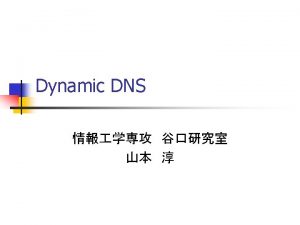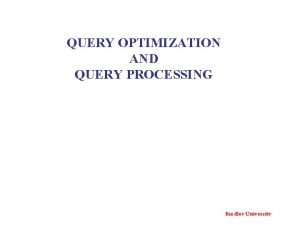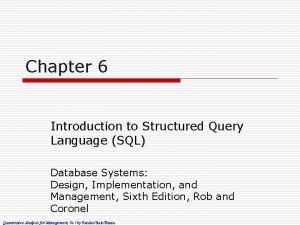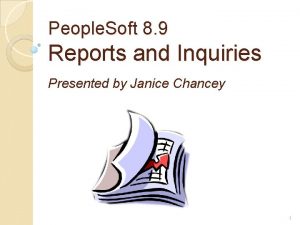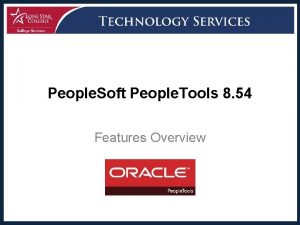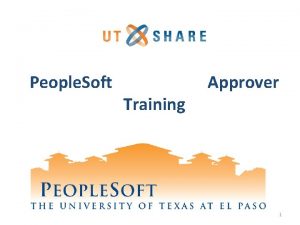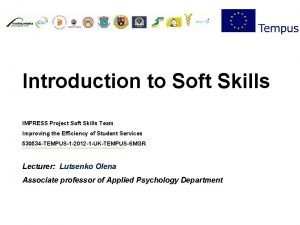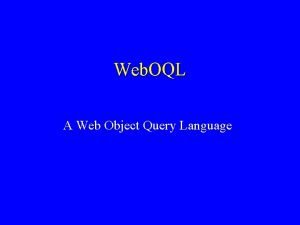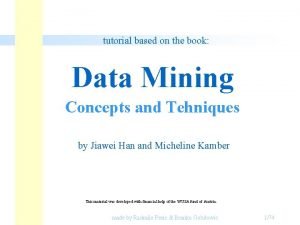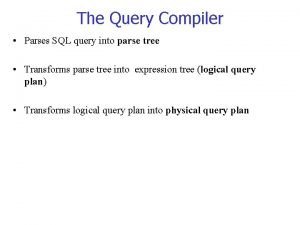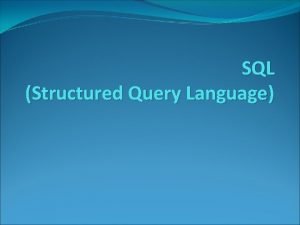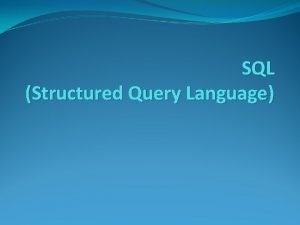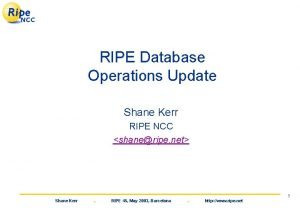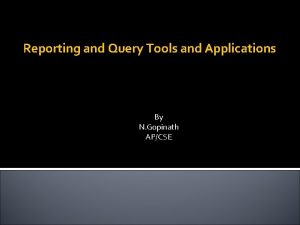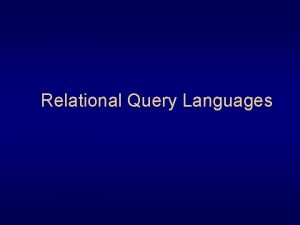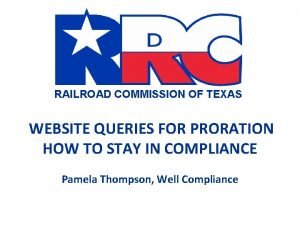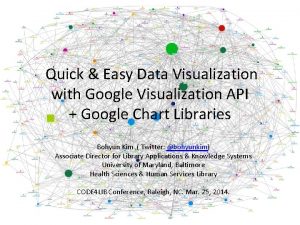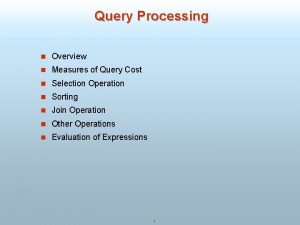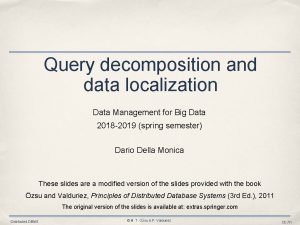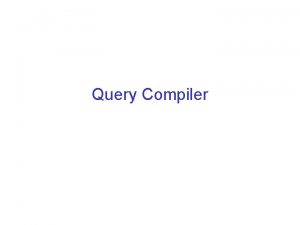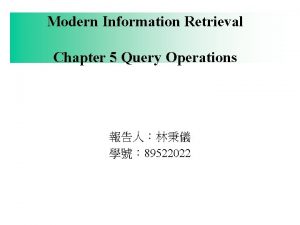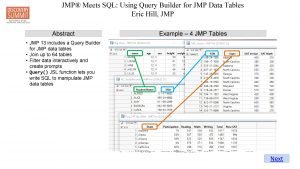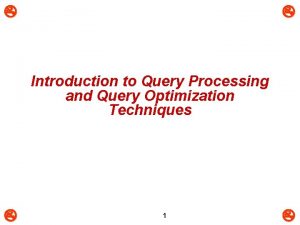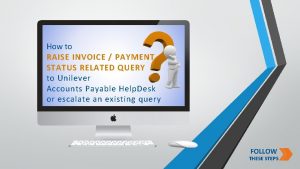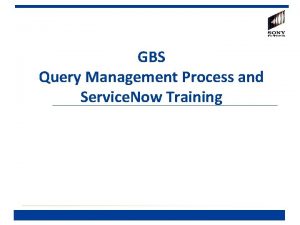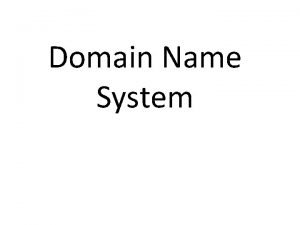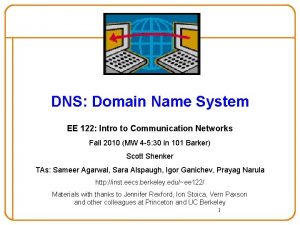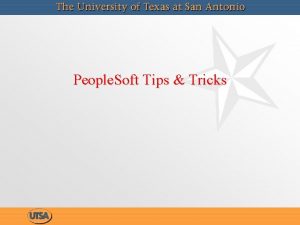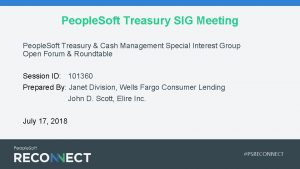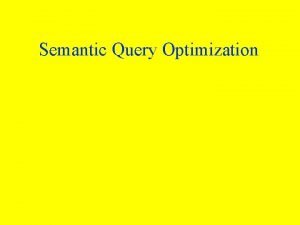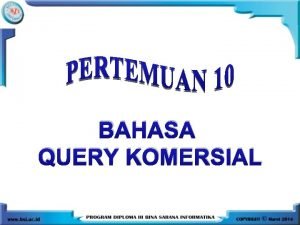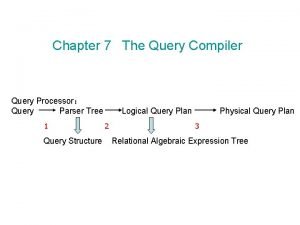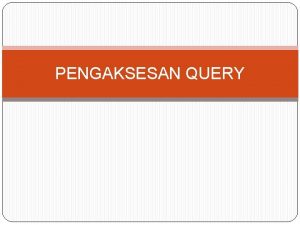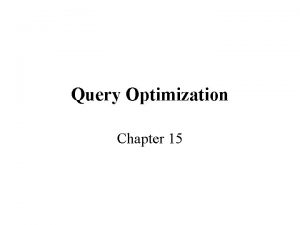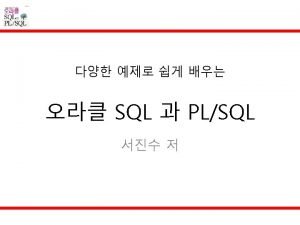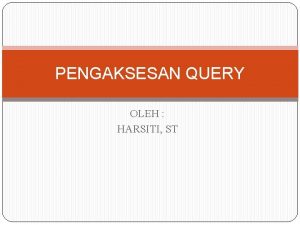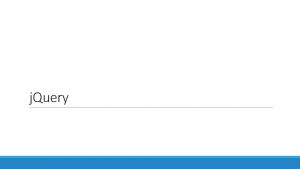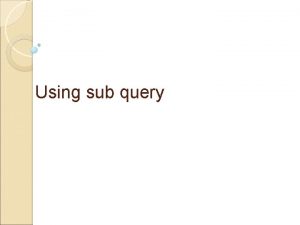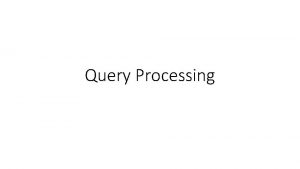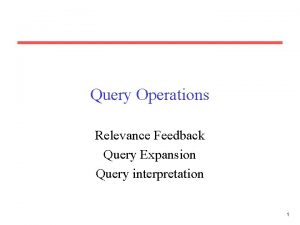Course Introduction Welcome to People Soft Query People


























































- Slides: 58


Course Introduction Welcome to People. Soft Query! People. Soft Query is a data extraction tool that all ctc. Link People. Soft users are able to access and use. A Query is simply a set of instructions on what data to pull from the system.

Course Goal The goal of this course is to teach end users of ctc. Link People. Soft to find and retrieve Queries and Reports in the most effective manner. Course Learning Objectives At the end of this course users will: • Understand Query Development Requests and Query Migration • Access People. Soft Query Viewer and Schedule Query • Search for existing Queries using Wildcards. • Run Queries to multiple outputs. • Effectively use Meta. Link to search Query metadata. • Have knowledge of how to run reports created with BI Publisher.

Course Plan In this class we are going to learn how to request the development of a new Query as well as how to find and run existing Queries. We are also going to learn how to use Meta. Link to search Query metadata and how to find and run BI Publisher reports.

Requesting Query Development Before requesting a new query be created it is important to always search existing queries first. Sometimes, there may not already be an existing query to meet your needs. In this case you will need to follow your institutions guidelines for getting your request to one of your college’s query developers. Each college has multiple query developers to handle requests for query development and/or modifications. Additionally, the State Board has staff that can assist the college query developers with development and modification requests. If you don’t know your college’s process for development requests, please contact Paula Mc. Daniel at: pmcdaniel@sbctc. edu

Query Protocol Query Migration is the process by which queries are moved from PCD (Production College Development) to PRD (Production). Query Developer Writes Query in PCD Data Services Team Checks out Query Moved to Production Query Migrations occur twice a week on Tuesdays and Thursdays. To be migrated on Tuesday submit the migration request ticket to Data Services by Monday at 3 pm. To be migrated on Thursdays, submit the migration request ticket to Data Services by Wednesday at 3 pm. Query requests sent for migration by Monday at 3 pm will be in PRD on Wednesday Morning , while those sent in by 3 pm on Wednesday, will be in PRD by Friday morning.

Log in to PS Query

Using PS Query Once you have logged into People. Soft there are two main areas in PS Query you will be able to access: • Query Viewer • Schedule Query Viewer: Main Menu Reporting Tools Query Viewer Schedule Query: Main Menu Reporting Tools Query Schedule Query Log in to People. Soft and follow the path to go to Query Viewer.

Searching Using Query Viewer Basic Search Detailed Instructions

Searching Using Query Viewer Advanced Search

Searching Using Query Viewer _ Wildcards Using Wildcards to Search % _ replaces a single character. % replaces a string of characters. It can be used in front of or in back of the search term. Use the wildcard character as the literal character. % Use the wildcard character as the literal character.

Searching Using Query Viewer Options Refine search results by selecting folders to search in. • Run results to: HTML • Schedule the Query • Add the Query to Favorites Excel XML

Schedule Query is used exclusively for scheduling a Query to run at a future time or to run Queries with large results. Schedule Query can be accessed through: • Query Viewer • People. Soft menu path

Schedule Query From Query Viewer – Detailed Instructions Query Viewer

Schedule Query From Query Viewer – Detailed Instructions A Run Control ID is a database record that provides values for Query parameters. Instead of entering the same values each time you run a Query, you can create and save a Run Control ID with those settings. Run Control ID’s are “private” and are only visible to you. Careful though! It is very hard to delete them!

Schedule Query From Query Viewer – Detailed Instructions Schedule Query Enter a description for the Query Run Control ID in the Description Field. Update any Prompts. Process Scheduler Request Select the Time Zone, Date and Time to run the Query.

Schedule Query From Query Viewer – Detailed Instructions Process Monitor Report Manager

Schedule Query From Query Viewer – Detailed Instructions Can also be accessed through the Menu Path: Main Menu>People. Tools>Process Scheduler>Process Monitor You are able to see the status of Scheduled Query runs by: • • User ID Type Number of days past Server • • Name Instance from and to Run Status Distribution Status

Schedule Query From Query Viewer – Detailed Instructions Can also be accessed through the Menu Path: Main Menu > Reporting Tools > Report Manager You are able to filter the displayed reports by: • Folder • Instance from and to • Name • Created on Date • Number of Days past • Date Range

Schedule Query From Query Viewer – Detailed Instructions d e Sch n w r. O u o Y e l u y r e Qu Schedule a Query to Run via Query Viewer or Query Manager. CS – Search for and schedule QCS_TRAIN_STDNT_ENRL HC – Search for and schedule QHC_TRAIN_BENEFIT FS – Search for and schedule QFS_TRAIN_CUSTOMER Run Control ID Format NAME_TRAIN_RUNID Description Type Schedule Exercise Web HTM

Schedule Query From the Menu Path – Detailed Instructions Main Menu Reporting Tools Query Schedule Query Search for an existing Scheduled Query via: • Description • Query Name • Run Control ID Click on the “Add a New Value” tab to create a new Run Control ID.

Schedule Query From the Menu Path – Detailed Instructions Schedule Query Enter a description for the Query Run Control ID in the Description Field. Update any Prompts. Process Scheduler Request Select the Time Zone, Date and Time to run the Query.

Schedule Query From the Menu Path – Detailed Instructions Process Monitor Report Manager

Schedule Query From the Menu Path – Detailed Instructions Can also be accessed through the Menu Path: Main Menu>People. Tools>Process Scheduler>Process Monitor You are able to see the status of Scheduled Query runs by: • • User ID Type Number of days past Server • • Name Instance from and to Run Status Distribution Status

Schedule Query From the Menu Path – Detailed Instructions Can also be accessed through the Menu Path: Main Menu > Reporting Tools > Report Manager You are able to filter the displayed reports by: • Folder • Instance from and to • Name • Created on Date • Number of Days past • Date Range

Schedule Query From Schedule Query Menu Path – Simplified Instructions d e Sch n w O r u o Y ule y r e Qu Schedule a Query to Run via Schedule Query. CS – Search for and schedule QCS_TRAIN_STDNT_ENRL HC – Search for and schedule QHC_TRAIN_BENEFIT FS – Search for and schedule QFS_TRAIN_CUSTOMER Run Control ID NAME_TRAIN_RUNID 2 Description Schedule Exercise Type Web Format XLS

Meta. Link http: //dataservicesmetalink. sbctc. edu/ Meta. Link is a data dictionary provided by Data Services where users can search for Queries, Reports, Records and View Scripts. Use Meta. Link to search records for both field and record information to gain valuable insight into the data structure.

Finding the Record and Field Information Meta. Link Data Dictionary Reports Click on Meta Data to go to the Reporting Library. Click on View Current Data Dictionary. Select the Pillar and Record and click View Report to see Record and Field Information.

Finding the Record and Field Information Meta. Link Data Dictionary Reports Table Information holds details regarding the record while Column Information holds details regarding the fields of the table.

Meta. Link Data Dictionary Reports – Record Information Record details are found under the header TABLE INFORMATION. The available fields are: Record Information Table Name Alternative Table Name Table Description Business Use Description Parent Child Business Rules Pillar Module Description Name of the Record The laymen name for the record. For example, the record STDNT_ENRL is commonly referred to as the Student Enrollment table. Description of the record and what it is used for. Any pertinent information regarding the record. Description of the business use of the record. A parent-child hierarchy is a hierarchy in a standard dimension that contains a parent attribute. A parent attribute describes a self-referencing relationship, or self-join, within a dimension main table. Parent-child hierarchies are constructed from a single parent attribute. The Pillar the record belongs to. The Module the record pertains to.

Meta. Link Data Dictionary Reports – Field Information Field details are found under the header COLUMN INFORMATION. The available fields are: Field Information Alternative Column Name Description The laymen name for the column. The description of the field and what it is used for. Any pertinent information regarding the field should be included. Primary Key Indicates if this field is part of the primary key for the record (table). The combination of primary key fields represent the uniqueness of the row in the record. Data Type A classification identifying one of various types of data, such as integer, text or decimal, that determines the possible values for that type. Size The length or scale of the field value. Size is directly related to the Data Type. Nullable Indicates of the field can contain null or blank values. Data Classification The WA State Office of the Chief Information Officer (OCIO) data classification. Category 1 thru 4 are used with Category 1 being public information and category 4 being confidential information requiring special handling. History Includes any historical changes to the field such as inclusions or exclusions of values. Accountable Designated by the Data Governance Committee and indicates which system commission Commission is ultimately accountable for this specific data element. Examples of Use Provides examples of provide an example of how/when to use the field. Information about auto joins and how they might affect the Query, etc. Converted: The table and field name of the legacy source record if converted during implementation. Common Used only by SBCTC. Column: Notes Any other notes, pertinent information regarding the field. Valid Values Field values and their meanings.

Do It Yourself: Meta. Link – Simplified Instructions • Go to page 52 of your manual to find the instructions for using the Meta. Link to find Record and Field information. CS • Look up PS_STDNT_GRPS HC • Look up PS_PAY_CHECK FS • Look up PS_CUSTOMER

Meta. Link Query, Report and Pivot Grid Search Click on Meta Data to go to the Reporting Library. Click on View Query, Report and Pivot Grid Search. Users can search queries, reports and pivot grids from the same search page.

Meta. Link Query, Report and Pivot Grid Search When using Query, Report and Pivot Grid Search, each search criteria may not actually apply to all three objects. There is a Definitions box to the right of the search criteria, which explains which search criteria affects which tab.

Meta. Link Query, Report and Pivot Grid Search If you want to search a specific pillar you can select it in the “All Pillars” box. If you want to search across all three pillars simply leave “All Pillars” selected. Queries, reports and pivot grid results will be returned based on your selection.

Meta. Link Query, Report and Pivot Grid Search Selecting a module will narrow the search to only return Reports based on the selected module. Queries and Pivot Grids will display all inventory.

Meta. Link Query, Report and Pivot Grid Search for queries in either a specific folder or across all folders. The search filter results on the Queries tab only. Reports and Pivot Grids will display all inventory.

Meta. Link Query, Report and Pivot Grid Search In the Fields box, enter field names to find results. Commas act as an “OR ” separator allowing for multiple fields to be searched. It is not possible to search multiple fields based on an "AND" logic at this time. The search will produce results in the Queries and Pivot Grids tabs. The Reports tab will display all inventory.

Meta. Link Query, Report and Pivot Grid Search The “Free Text Search” box will search across all columns in all three tabs returning any results which contains the word or words entered. Up to five terms can be separated by a comma for an "OR" logic separation or a space which acts as "AND" separation logic.

Meta. Link Query, Report and Pivot Grid Search Queries Tab Results The Queries Tab will show queries that match the search criteria or all query inventory if no criteria apply to query search. Click on the hyperlinked query name to bring up additional details.

Meta. Link Query, Report and Pivot Grid Search Reports Tab Results The Reports Tab will show reports that match the search criteria or all report inventory if no criteria apply to the report search. Click on the hyperlinked report name to bring up additional details.

Meta. Link Query, pivot grid and Pivot Grid Search Pivot Grids Tab Results The Pivot Grids Tab will show pivot grids that match the search criteria or all pivot grid inventory if no criteria apply to the pivot grid search. Click on the hyperlinked pivot grid name to bring up additional details.

Meta. Link View Script Search Click on Meta Data to go to the Reporting Library. Click on View Script Search. Enter the beginning of the View name. The results will display below. Click on the hyperlink to view the Script details.

Meta. Link Adding Information to Meta. Link Adding information to Meta. Link is one of the most important tasks we have as Query Developer’s. As we gain information about data structure and business uses of different Fields and Records we have an obligation to all our fellow Query Developer’s to share it. It is quick and easy to add in information. Click on Edit Meta Data Select the Pillar, Record and Field you would like to modify. Type in the new information. Scroll to the bottom of the screen when finished and click Save Data.

BI Publisher Oracle Business Intelligence Publisher (BI Publisher, formerly XML Publisher) is an enterprise reporting solution that streamlines report and form generation. In essence BI Publisher allows the State Board to create actual formatted reports using Queries, Connected Queries or other data sources and then allow the end users the option of how the report should be rendered. Users are able to select to view a report on the Web, in Excel, Word or Adobe. The BI Publisher report naming convention prefixes will be: • BCS - Campus Solutions • BFS - Finance • BHC - Human Capital Management The rest of the BIP report name will follow the standard query naming convention. For the purpose of this class we are going to be looking at how to view Query based BI Publisher reports through Query Report Viewer, how to run a BI Publisher report using Query Report Scheduler and using BI Publisher Report search. .

BI Publisher Query Report Viewer The BI Publisher Query Report Viewer allows end users to run Query based BI Publisher reports. Note: BI Publisher reports with data sources other than Query do not appear in search results and will need to be scheduled to run. Navigate to Query Report Viewer: Main Menu Reporting Tools BI Publisher Query Report Viewer There are two search methods: Basic Search and Advanced Search. Basic Search Advanced Search

BI Publisher Query Report Viewer Enter your search Criteria or simply hit enter for a list of all available reports Users are able to select how the report should be displayed in the Format column. Available options are: • PDF • HTM • RTF • XLS

BI Publisher Query Report Viewer Once the Format selection is made, click on “View Report” to see the report results.

BI Publisher Query Report Scheduler The Query Report Scheduler is similar to Schedule Query in that users are able to schedule reports to run at a specific time/date or immediately. All BI Publisher reports with data sources of Query or Connected Query are available to be run through this tool. Note: Do not schedule any Queries or Reports to run between the hours of 1 am and 3 am as this time is reserved for IT. The BI Publisher Query Report Scheduler is very similar in use and appearance to Schedule Query. Each report is assigned a Run Control ID which will tell the system when, where and how to run the report saving the report parameters (prompts) to the Run Control ID’s are personal and are not shared across the system.

BI Publisher Query Report Scheduler – Adding a New Run Control ID If adding a new Run Control ID, select the Add a New Value tab. Enter the Run Control ID and click on “Add”. Select the Report Name Once the Report Name is entered the most of the remaining fields will fill in automatically

BI Publisher Query Report Scheduler – Adding a New Run Control ID The Process Scheduler Request page is where final selections are made including the Date and Time to run the report as well as Type and Format. Once done with the selections click OK to schedule the report. You will be directed back to the Query Report Scheduler page where you will be able to check the Process Monitor and the Report Manager for your report.

BI Publisher Query Report Scheduler – Using an Existing Run Control ID From the main Query Report Scheduler page you are also able to search for an existing Run Control ID. There are two search options: Basic Search Advanced Search Wildcards are available to use in both search types. Enter your search criteria or simply hit enter for a list of all BI Publisher reports. Remember they are personal to you so only Run Control ID’s you have created will display here.

BI Publisher Query Report Scheduler – Using an Existing Run Control ID The list of Run Control ID’s will display as a hyperlink. Click the one to run. On the Query Report Scheduler page make any adjustments needed to the Parameters, if any. On the Process Scheduler page choose the type and Format View the Report Manager and Process Monitor on the Query Report Scheduler page

BI Publisher Report Search The BI Publisher Report Search will allow users to search specifically for the results of their scheduled BI Publisher reports. It is similar to Report Manager. Enter your search criteria then click the hyperlink of the report you would like to view. To download and/or view the report click on the Report Name in the File List box.

Course Exercises

Course Review The goal of this course was to teach end users of ctc. Link People. Soft to find and retrieve Queries and Reports in the most effective manner. The Objectives for this course were to give attendees the tools and necessary information to: • Properly create a Query Development Request and Understand Query Migration • Access People. Soft Query Viewer and Schedule Query • Search for existing Queries using Wildcards. • Run Queries to multiple outputs. • Effectively use Meta. Link to search Query metadata. • Have knowledge of how to run reports created with BI Publisher. To meet the Goal and Objectives we learned how to correctly create a development request and the steps for Query migration. We saw how to search for and run Queries in Query Viewer and how to schedule Queries to run. We learned how to run Queries to multiple outputs and use Wildcards in searches. We also became knowledgeable about Meta. Link and how it can be a very useful tool for finding information and how to run and schedule reports created through BI Publisher.


Break Time!!!!
 Iterative query vs recursive query
Iterative query vs recursive query Query tree and query graph
Query tree and query graph Query tree and query graph
Query tree and query graph Ntust course query
Ntust course query Language
Language Introduction to structured query language (sql)
Introduction to structured query language (sql) Wise men three clever are we
Wise men three clever are we You welcome my dear
You welcome my dear Disadvantages of cavity wall
Disadvantages of cavity wall Course number and title
Course number and title Chaine parallèle muscle
Chaine parallèle muscle People soft 8
People soft 8 People soft
People soft People soft utep
People soft utep Peoplesoft utep
Peoplesoft utep Introduction to soft skills
Introduction to soft skills Introduction to soft-collinear effective theory:
Introduction to soft-collinear effective theory: Why did angelou leave egypt and move to ghana?
Why did angelou leave egypt and move to ghana? Opening prayer for meeting
Opening prayer for meeting Introduction to banking course
Introduction to banking course Imbe introduction course v2
Imbe introduction course v2 Introduction to software engineering course outline
Introduction to software engineering course outline Ron had a course introduction
Ron had a course introduction Cleft sentences examples
Cleft sentences examples Ron had a course introduction
Ron had a course introduction My structured query language
My structured query language Oql query examples
Oql query examples Palo alto suspicious dns query
Palo alto suspicious dns query Starnet query model
Starnet query model Aggregate operation in relational algebra
Aggregate operation in relational algebra Sfw query
Sfw query Rrc wellbore query
Rrc wellbore query Eurostat query builder
Eurostat query builder Language
Language Pengertian query
Pengertian query Online query optimizer
Online query optimizer Ripe database download
Ripe database download Reporting and query tools in data mining
Reporting and query tools in data mining Relational query languages in dbms
Relational query languages in dbms Rrc severance query
Rrc severance query Rrc wellbore query
Rrc wellbore query Google data visualization api
Google data visualization api Steps in query processing
Steps in query processing Query decomposition in dbms
Query decomposition in dbms Sfw query
Sfw query Raksha health insurance tpa
Raksha health insurance tpa Moloch query examples
Moloch query examples Query operations in information retrieval
Query operations in information retrieval Truyvn
Truyvn Jmp sql
Jmp sql Query optimization steps
Query optimization steps Wildcard queries in information retrieval
Wildcard queries in information retrieval Https://doi.crossref.org/simpletextquery
Https://doi.crossref.org/simpletextquery Supplier query form unilever
Supplier query form unilever Query management process
Query management process Enum query ims
Enum query ims Contoso
Contoso Recursive and iterative query
Recursive and iterative query Azure cosmos db query cheat sheet
Azure cosmos db query cheat sheet
